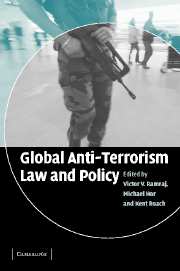Book contents
- Frontmatter
- Contents
- List of contributors
- Acknowledgements
- 1 Introduction
- PART ONE Theoretical Perspectives on Anti-Terrorism Law and Policy
- PART TWO A Comparative Study of Anti-Terrorism Measures
- 7 The criminal law and terrorism
- 8 And fairness for all? Asylum, national security and the rule of law
- 9 The financial war on terrorism
- 10 Terrorism and technology: policy challenges and current responses
- 11 Recent developments relating to terrorism and aviation security
- 12 International responses to combat maritime terrorism
- PART THREE Anti-Terrorism Law and Policy in Asia
- PART FOUR Regional Cooperation
- PART FIVE Anti-Terrorism Law and Policy in the West
- PART SIX Anti-Terrorism Measures in Africa, the Middle East and Argentina
- Index
7 - The criminal law and terrorism
Published online by Cambridge University Press: 21 July 2009
- Frontmatter
- Contents
- List of contributors
- Acknowledgements
- 1 Introduction
- PART ONE Theoretical Perspectives on Anti-Terrorism Law and Policy
- PART TWO A Comparative Study of Anti-Terrorism Measures
- 7 The criminal law and terrorism
- 8 And fairness for all? Asylum, national security and the rule of law
- 9 The financial war on terrorism
- 10 Terrorism and technology: policy challenges and current responses
- 11 Recent developments relating to terrorism and aviation security
- 12 International responses to combat maritime terrorism
- PART THREE Anti-Terrorism Law and Policy in Asia
- PART FOUR Regional Cooperation
- PART FIVE Anti-Terrorism Law and Policy in the West
- PART SIX Anti-Terrorism Measures in Africa, the Middle East and Argentina
- Index
Summary
Many societies instinctively and quickly reach for the criminal law as a response to terrorism. The criminal law has frequently been expanded as a direct response to acts of terrorism. In the first part of this chapter, I will provide an overview of how new criminal laws have often been produced in response to terrorism and relate this to narrative, memorial, and communicative uses of the criminal law and increased concern about the rights of victims and potential victims of crime. New anti-terrorism laws, however, are not solely based on a symbolic focus on state punishment and denunciation. They also incorporate a more modern approach that sees crime as one of the many risks of modern society. The risk of crime can only be managed by enlisting non-state actors in the crime control enterprise.
In the second part of the chapter, I will examine some of the dangers of the criminal law solution to terrorism from both instrumental and normative dimensions. The enactment of new criminal laws after acts of terrorism implies that the existing criminal law was inadequate to respond to acts of terrorism. The accuracy of such a claim, however, depends on the baseline established by the ordinary criminal law in each particular jurisdiction.
- Type
- Chapter
- Information
- Global Anti-Terrorism Law and Policy , pp. 129 - 151Publisher: Cambridge University PressPrint publication year: 2005
- 4
- Cited by

